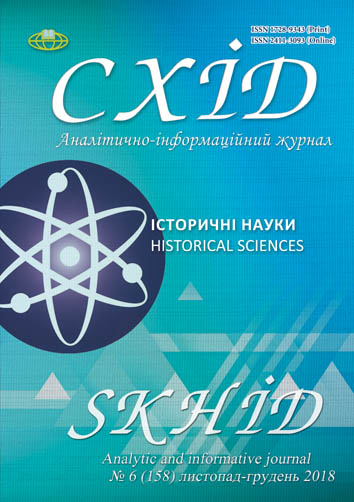Stalingrad strategic defense operation (17.07 - 18.11.1942): expenses and prospects in operational commanding by tank war
DOI:
https://doi.org/10.21847/1728-9343.2018.6(158).155196Keywords:
Stalingrad strategic defensive operation, tank army, corps, frontAbstract
Stalingrad was one of the main goals of the offensive of German troops and its allies on the Eastern front in summer- autumn 1942.This city was an important communication station and one of the main production centers of military products in the USSR and named after Stalin.
The Stalingrad front got a task defending in a strip width of 530 (on the river Don from Babka to Kletskaya, and along the line Kletskaya, Surovikino, Suvorovskyi, Verkhne-Kurmoyarskaya), to stop further advancing of the enemy and prevent it from reaching to theVolga. The mobile units were extremely needed to stop the enemy. Soon, on the base of the 38-th and the 28-th armies they began the formation of the 1st and the 4th tank mixed composition armies (in the newly formed tank mixed composition armies together with the tank units included rifle divisions of the Red Army.
For the creation of a new front of defense, the Soviet Troops moved forward to take their positions in the terrain, which were not previously prepared for the defense. The most of compounds were new formations of Stalingrad Front which were not fully formed and typically without combat experience.
The place and role of tank troops were analyzed during the counteroffensives and counterattacks for reinforcement of anti-tank defense. This critical assessment of the organization and conduction of the defense made a number of disadvantages: interaction between troops, especially between tank armies, which inflicted counteroffensive as were not formed at that time and were only manned by 40-50% of material support; unsimultaneous transition of percussion groups to the warfare; introduction to the battle of tank armies partially, without previous enemy intelligence and reconnaissance, without reliable artillery support and low air support.
It led to the colossal losses of the Red Army: the exact numbers of losses personnel and equipment are still not named, but only the 13th Tank Corps during the defensive phase of battle lost 550 tanks (four times he received a complete set of combat equipment and lost it); totally, 8 Tank Corps and 12 sepаrate tank brigades of the Red Army took part in this phase and the level of losses was nearly the same. It became a consequence of permanent attempts Orders of Headquarters of Command to counterattack and reject the enemy, without focusing on sufficient strength and without exploration of the reconnaissance.Downloads
References
Adam, V. 1967. Difficult decision [translat.]. Moscow.
Andronikov, V.M. and Burikov, P.D. and Gurkin, V.V. etc. 1993. The heading of secrecy is removed: Loss of the Armed Forces of the USSRin wars, hostilities and military conflicts: Statistical research. Military Publishing, Moscow, 415 p. (rus).
Central Archive of the Ministry of Defense of the Russian Federation, fond 132a, opys 2642, Spr. 32.
Central Archive of the Ministry of Defense of the Russian Federation, fond 220, opys 235, Spr. 6/2.
Central Archive of the Ministry of Defense of the Russian Federation, fond 3430, opys 1, Spr. 34.
Central Archive of the Ministry of Defense of the Russian Federation, fond 48, opys 451, Spr. 41.
Central Archive of the Ministry of Defense of the Russian Federation, fond 345, opys 5512, Spr. 14.
Dankovich, S. P. 2015. The military-strategic position on the southern front to the beginning of the Tuapse defensive operation. Bulletin of the VolSU. Series 4, History. Regional Studies. International relationships. №4. Available at: https://cyberleninka.ru/article/n/voenno-strategicheskoe-polozhenie-na-yuzhnom-fronte-k-nachalu-tuapsinskoy-oboronitelnoy-operatsii (Accessed: 24.10.2018).
Doerr, H. 1955. Der Feldzug nach Stalingrad. Versuch eines operativen Überblickes. Darmstadt.
Gorelov, V.I. 2005. The Kharkiv operation of 1942. In: Ukraine in the flames of the war of 1941-1945. Ukrainian Publishing House. Kyiv: 560 pp. (ukr).
History of wars and military art. 1970. Military Publishing,Moscow: 560 p. (rus).
Isaiev, A.V. 2008. Stalingrad. Beyond the Volga there is no land for us. Yauza, Eksmo, Moscow: 448 p. (rus).
Jacobsen, Hans-Adolf. 1959. 1939-1945. Der Zweite Weltkrieg in Chronik und Documenten. 3.durchgesehene und erganzte Auflage. Wehr-und-Wissen Verlagsgesselschaft. Darmstadt,.
Moskalenko, K.S. 1973. In southwesterly direction. Memories commander. Book 1. Military Publishing, Moscow: 456 p. (rus).
Rokossovskii, K.K. (ed.) 1965. Great victory on the Volga. Military Publishing, Moscow: 528 p. (rus).
Rotmistrov, P.A. 1963. History of military art. Vol. 2. Military Publishing, Moscow: 720 pp. (rus).
Russian archive: Great Patriotic War: Supreme Command Rate: Documents and materials: 1942. T. 16 (5-2). 1996. TERRA, Moscow, 624 p. (rus).
Samsonov, A.M. 1989. Battle of Stalingrad, 4th ed. Nauka,Moscow: 604 p. (rus).
Strokov, A.A. 1966. History of military art. Under the general editorship of the doctor of historical sciences, professor, colonel. Voenizdat, Moscow: 656 pp. (rus).
Taylor, A.J.P. 1975. The Second World War. Hamish Hamilton, London.
Vasilevsky, A.M. 2001. A matter of life. OLMA-PRESS Star World, Moscow (rus).
Yeremenko, A.I. 1961. Stalingrad. Military Publishing, Moscow. 504 p. (rus).
Downloads
Published
How to Cite
Issue
Section
License
Copyright (c) 2019 Leonid Kryvyzyuk

This work is licensed under a Creative Commons Attribution-NonCommercial-NoDerivatives 4.0 International License.
1. Authors bear responsibility for the accuracy of facts, quotations, numbers and names used.
2. Manuscripts are not sent back.
3. The publisher does not always agree with the authors' opinion.
4. The authors reserve the right to authorship of the work and pass the first publication right of this work to the journal under the terms of a Creative Commons Attribution-NonCommercial-NoDerivatives 4.0 International License. This license allows others to distribute (copy) the published work for non-commercial purposes, provided there is mandatory attribution to its authors and a link to the first publication in our journal.
5. The authors have the right to conclude separate supplement agreements that relate to non-exclusive work distribution in the form in which it has been published by the journal (for example, to upload the work to the online storage of the journal or publish it as part of a monograph), provided that the reference to the first publication of the work in this journal is included.

